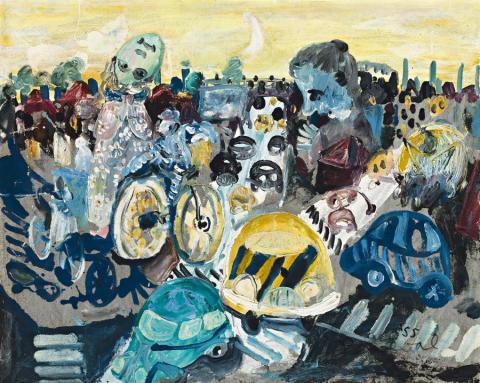PEDESTRIAN CROSSING, 1954/55
JOHN PERCEVAL
oil and tempera on cheesecloth on composition board
73.0 x 92.0 cm
signed and inscribed verso with title
Acquired directly from the artist
Private collection, Sydney
John Perceval: A Retrospective Exhibition, National Gallery of Victoria, Melbourne, 30 April – 12 July 1992, Art Gallery of New South Wales, Sydney, 6 August – 20 September 1992 (label attached verso)
Allen, T., John Perceval, Melbourne University Press, Melbourne, 1992, pp. 111–112, 156 (illus.)
In Pedestrian Crossing 1954/55, the first impression is one of chaos as everything conspires to converge at the very moment safe passage is sought across the road marked crossing. John Perceval's agitated expressionist brush strokes and choice of colours are ideally suited to the subject - figuratively and emotionally. To add further to the confusion, Perceval dispensed with any rational depiction of space in a topsy turvey world of cars, bicycles, roadways, road stripes and people. Its child-like irrationality and emotional impact is suggestive of the surreal world of dreams in which nothing is quite right. During the early fifties Perceval adopted a deliberate naivety of style as in Adam and Eve with Garlic Plant 1952. Those paintings of his children such as Matthew, Tessa and Winkie in a Field of Flowers 1954/55, show them 'with large eyes and long fair hair in a remote dream-like aura with Perceval's Volkswagen a Rabelaisian hump in the background.'1 The presence of the Volkswagen car is significant, newly acquired by the artist and an important means to move around Melbourne to such painting sites as Williamstown and to the nearby bush. The car was clearly a novelty that spilled over into his painting, the Pedestrian Crossing expressing something of the not so enjoyable aspects of city driving. At the time it was painted, Perceval and his family were living in the Melbourne suburb of Canterbury. The madness of this traffic scene full of Volkswagen cars fondly known as 'beetles' is most likely a nightmare kind of recollection of a visit to the city from the suburbs. The blue figure in profile in the upper right appears to be Perceval himself, trapped in a concrete jungle of buildings and roads where cars have taken over. It is interesting to reflect that some years later, in 1974, Peter Weir produced his first feature film, The Cars that Ate Paris, Paris being a fictional small Australian country town.
1. Plant, M., John Perceval, Lansdowne Press Pty Ltd, Melbourne, 1971, p. 52
DAVID THOMAS
